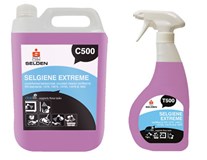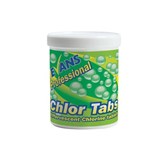Evans Protect Disinfectant Cleaner
Multi-purpose, perfumed detergent and disinfectant. Effective against a range of bacteria and enveloped viruses.
Passes EN 16777 and 14476; effective against enveloped viruses, including Coronavirus and helps to prevent
cross-contamination.
DISINFECTING HARD SURFACES & EQUIPMENT:
PASSES (see microbiological profile for further info)
DILUTION CONTACT TIME
EN 16777 - enveloped viruses (eg. Coronaviruses) 1:15 1 min
EN 1276 - bactericidal 1:25 30 sec
Dilute concentrate with clean water in spray bottle or bucket.
- For virucidal applications: 50 ml per 750 ml diluted solution.
- For bactericidal applications: 30 ml per 750 ml diluted solution.
Clean surfaces before disinfection.
Apply to surface by spray, clean cloth or mop. Leave on surface for the required contact time.
Wipe with a clean cloth and allow to air dry.
GENERAL CLEANING:
For non-disinfection cleaning tasks.
Dilute 1:50 with clean water (100 ml per 5 L diluted solution). Mop or wipe surface.
To prevent chemical build up, surfaces should be periodically washed.
After use we recommend cloths/mops are rinsed in a fresh solution of Protect and allowed to air dry.
• Kills a wide range of bacteria and yeast; passes EN 1276, EN 16615 and EN 1650.
• For use in schools, hospitals, nursing homes or wherever there is a risk of infection.
• Ideal in the leisure industry for equipment, sunbeds, steam rooms and saunas.
• Suitable for use on all hard washable surfaces. Leaves a clean, fresh fragrance.
• Approved for POLYFLOR flooring.
• Available in a ready-to-use formulation supplied in 750 ml spray bottles.
PRODUCT INFORMATION:
Appearance: Clear blue liquid
Odour: Floral
pH - undiluted: 12.0
Shelf life: 3 years
COMPOSITION:
Contains a blend of quaternary ammonium
compound, sequestering agent, nonionic
surfactant, perfume and dye.
BIODEGRADABILITY:
All surfactants used in Evans Vanodine products
comply with the current European Regulations
concerning biodegradability and protection of the
environment.
PROTECT MICROBIOLOGICAL PROFILE
INTRODUCTION
PROTECT is a concentrated quaternary ammonium based cleaner and multi-surface disinfectant.
PROTECT is bactericidal and yeasticidal. It is also effective against enveloped viruses including coronavirus.
PROTECT is perfumed and can be used in schools, hospitals, nursing homes as well as in the leisure industry for equipment, sunbeds,
steam rooms and saunas.
PROTECT is suitable for use on all washable hard surfaces leaving a clean, fresh fragrance.
PROTECT - EFFICACY SUMMARY
PROTECT has been tested and proven to be effective against a range of micro-organisms. European Standard (EN*) test methods were used to
prove efficacy against bacteria, viruses and yeast.
The UKAS accredited Microbiology Laboratory at Evans Vanodine International PLC. (Testing number 1108) performed tests with bacteria and yeast.
In addition, Virus tests EN 14476 and EN 16777 have been performed by an independent expert laboratory.
*EN - European Norm
The following tables include information of relevant, applicable test methods, conditions and contact times.
ACTIVITY AGAINST BACTERIA
ACTIVITY AGAINST ENVELOPED VIRUSES
ACTIVITY AGAINST YEAST
BACTERIA TEST PROFILE
ORGANISMS DILUTION TEST METHOD TEMP (°C) CONTACT TIME
(MINUTES) SOIL LEVEL
Enterococcus hirae
1:200
EN 1276 20
30 Seconds Dirty
1:200 5 Dirty
Escherichia coli
1:50 30 Seconds Dirty
1:50 5 Dirty
Legionella pneumophila 1:100* 5 Dirty
Methicillin resistant Staphylococcus aureus 1:200 5 Dirty
Pseudomonas aeruginosa
1:25 30 Seconds Dirty
1:25 5 Dirty
Salmonella typhimurium 1:50 5 Dirty
Shigella sonnei 1:50 5 Dirty
Staphylococcus aureus
1:50 30 Seconds Dirty
1:100 5 Dirty
Enterococcus hirae 1:100
EN 16615** Room
temperature 1 Dirty
Escherichia coli 1:100
Pseudomonas aeruginosa 1:25
Staphylococcus aureus 1:50
* PROTECT is suitable for disinfecting showerheads only and should not be used in water systems for the control of Legionella.
VIRUS TEST PROFILE
VIRUS FAMILY ORGANISMS DILUTION TEST METHOD TEMP (°C) CONTACT TIME
(MINUTES) SOIL LEVEL
Poxvirus Vaccinia virus
1:15 EN 14476 20 5 Clean
1:25 EN 16777 Room
temperature 1 Clean
HARD SURFACE PRODUCT TEST METHODS
For the Biocidal Product Regulation (BPR) there are two product types applicable to hard surface disinfectants. Product Type 2; Disinfectants used
for the disinfection of surfaces, materials, equipment and furniture which are not in direct contact with food or feeding stuffs. And Product type
4; Disinfectants used for the disinfection of equipment containers, consumption utensils, surfaces or pipework associated with the production,
transport, storage or consumption of food or feed for humans and animals.
As a minimum for general purposes products should be effective against bacteria and yeast.
There are 3 claims that can be made when virus tests are used, full virucidal activity, limited spectrum virucidal activity and activity against enveloped
viruses. The virucidal claim will depend on the viruses tested.
The scope of food area EN methods applies to disinfectants used in food, industrial, domestic, institutional areas, excluding areas and situations
where disinfection is medically indicated, and products used on living tissue except those for hand hygiene in the above areas.
All EN test methods define test conditions specific for the areas where disinfectant will be applied.
Contact times in general are between 1 minute and 60 minutes depending on the application of the product. e.g. products to be sprayed and wiped
off will have shorter contact times.
The interfering substance used in EN test methods is described as dirty or clean in medical, food, industrial, domestic and institutional areas, They
simulate levels of soil encountered in practical and real-life situations.
Generally disinfectant activity improves in warm water, under clean conditions. If the temperature is less than 20°C with dirty conditions a longer
contact time may be necessary.
There are two types of laboratory test method for disinfectants i.e. suspension methods and surface methods. They are both quantitative and involve
adding a test inoculum (mixture of test organism and interfering substance) adding the disinfectant, sampling at specified times, neutralising the
sample and then calculating the number of surviving organisms.
Surface methods use different carriers depending on the application area, e.g. stainless steel discs, depending on the application area, e,g, stainless
steel discs (food) glass slides, PVC tiles (medical) wood, synthetic skin (veterinary). the inoculum is dried on to the surface before the disinfectant is
applied, Mechanical action is employed by using wipes in certain methods.
EN TEST METHODS
TEST REFERENCE TEST TYPE ORGANISM TEST PASS CRITERIA
EN 1276 For bactericidal activity in the food, industrial, domestic and institutional
areas. Suspension Bacteria ≥5 log reduction
EN 1650 For fungicidal or yeasticidal activity in the food, industrial, domestic and
institutional areas. Suspension Fungi ≥4 log reduction
EN 14476 For virucidal activity in the medical area. Suspension Virus ≥4 log reduction
EN 16615
For bactericidal and/or yeasticidal activity in the medical area. For products
used to disinfect non-porous surfaces with a mechanical action. Modified
to use stainless steel carriers, interfering substance and Escherichia coli
parameters from food, industrial, domestic and institutional areas.
Surface Bacteria ≥5 log reduction
Surface Yeast ≥4 log reduction
EN 16777 For virucidal activity in the medical area. For products used to disinfect
non-porous surfaces. Surface Virus ≥4 log reduction
LOG REDUCTION
Products claiming they will kill 99.9% of bacteria sounds extremely efficient, however it does not prove that a product is an effective disinfectant.
In order to demonstrate effectiveness disinfectants should be tested using European Standard Test Methods. Depending on the applicable area and
test used, relevant log reductions are specified and must be achieved to claim effectiveness with a test method. This means a reduction in microbial
numbers must be seen when compared to the number of organisms at the start of the test or, for surface tests, to a water control performed at the
same time. As the numbers are large it is generally accepted that they are expressed as a logarithm. The reduction can be written as either a log
value or a percentage i.e. a 5 log reduction is equivalent to a 99.999% reduction, a 3 log reduction is equivalent to 99.9% reduction.
Bacteria are microscopic free living single celled organisms. A surface contaminated with raw meat for example could have millions of bacteria per
square centimetre. e.g. a surface with 1,000,000 bacteria treated with a product that kills 99.9% of bacteria would still have 1000 bacteria remaining.
If the surface was treated with a product that kills 99.999% of bacteria only 10 bacteria would remain.
Bacterial growth rates vary depending on the surface, type and degree of soiling, temperature and presence of water. E.coli (under ideal conditions)
multiplies in 15 minutes. If conditions are less than ideal e.g. lowering the temperature, or drying the surface, the growth rate slows down.
e.g. 1,000 bacteria would increase to 2,000 after 15 minutes, after 30 minutes it would be 4,000 and after 1 hour 16,000 and 256,000 after 2 hours,
10 bacteria would only have multiplied to 256 in the same 2 hour period.
The presence of bacteria does not automatically lead to infection, the vulnerability of the person and the infectious dose (number of bacteria required
to cause infection) are vitally important. Susceptible individuals such as the very young, elderly and sick are more at risk from an opportunistic
infection. Some bacteria will cause an infection with less than 100 cells ingested or introduced into cuts or wounds. For this reason, it is important
to reduce numbers of harmful bacteria to the lowest number possible wherever the risk of infection is high.
THE FOLLOWING FIGURES APPLY IF THE NUMBER AT THE START POINT WAS 1,000,000
LOG REDUCTION NUMBER REMAINING PERCENTAGE REDUCTION
1 100,00 90%
2 10,000 99%
3 1,000 99.9%
4 100 99.99%
5 10 99.999%-












